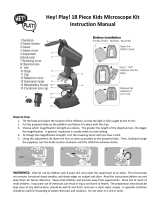
3
For optimum viewing satisfaction, follow these simple procedures. Nomenclature used to describe components and
controls can be identified by referring to the diagram at left.
UNPACKING
1. Carefully remove microscope, dustcover and warranty card. Always handle and move microscope by securely
holding the arm of microscope. Avoid touching any of the lens surfaces while handling the microscope. Dust, dirt, or
fingerprints can damage the delicate lens surfaces or adversely affect image quality.
2. Examine packing material before you discard it. Retain the styrofoam container in case you need to transport, store,
or return the microscope for service. If it becomes necessary to ship the microscope for any reason, pack it in the
styrofoam container, and then pack the styrofoam in another corrugated shipping container for optimum protection.
Use of the styrofoam alone will not provide adequate protection in transit, and will void your warranty.
DESCRIPTION OF COMPONENTS
1. EYEPIECE (ocular lens) Lens closest to the eye, magnifies the primary image formed by the objective lens. Dual
head models 132 and 139 feature both an inclined eyepiece (for primary viewing) and a vertical eyepiece for second
viewer or for mounting a camera. The inclined eyepiece is equipped with a “pointer” that rotates as the eyepiece is
turned.
2. DIOPTER ADJUSTMENT (on models 132 and 139 only) Permits focusing adjustment of image for any difference in
vision between primary and secondary viewers.
3. OBJECTIVE TURRET (nosepiece) Revolving turret which holds objective lenses, permits changes of magnification
by rotating different powered objective lenses into optical path.
4. OBJECTIVE LENS Lens closest to the object being viewed, forms first magnified image of the specimen.
5. STAGE CLIPS Two locked-on clips hold specimen slide in place on stage. Note: Your microscope is already drilled
and tapped to accept an optional mechanical stage. Mechanical stage replaces stage clips and permits precise,
mechanical manipulation of the specimen slide.
6. STAGE Platform of the microscope where the specimen slide is placed.
7. CONDENSER LENS An 0.65 N.A. condenser lens, fixed in center of stage, condenses light rays from substage
illumination and fills the back lens element of objective lens to improve image resolution.
8. DISC DIAPHRAGM Rotating disc located below stage, with holes of various apertures, designed to help achieve
optimum resolution of the objective lens. Larger apertures used for higher magnifications, and smaller apertures used
for lower magnifications.
9. SAFETY RACK STOP When properly adjusted, controls maximum upward travel of stage. Prevents higher power
objectives from breaking specimen slides, prevents damage to objective lenses. This stop has been pre-adjusted at
the factory.
10. FOCUSING KNOBS Coarse focusing knobs (larger knobs) located on each side of arm, raise or lower stage to
bring specimen image into focus. Fine focus knobs (smaller knobs located just below coarse focusing knobs) permit
more precise image adjustment.
11. ILLUMINATION Depending on model purchased, microscope is equipped with either a substage plano-concave
mirror or built-in electrical illumination.
a. Mirror provides illumination of specimen by reflecting light from an artificial source or natural sunlight.
b. Built-in substage electric illuminator provides constant, reliable, pre-focusing illumination.
Observe that the main voltage of your microscope is labeled on the back of the base. Make certain that
the main voltage of your microscope corresponds to the voltage of your power outlet, either 120v or 220v.










